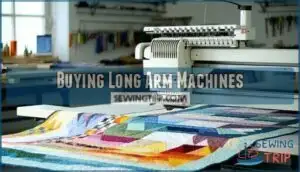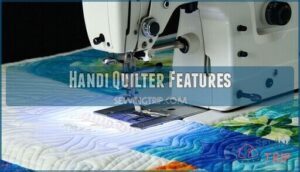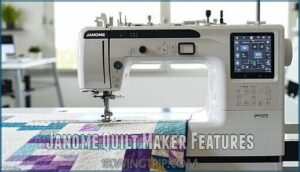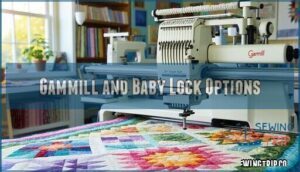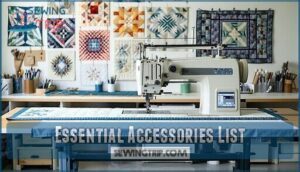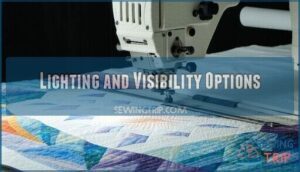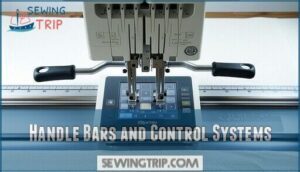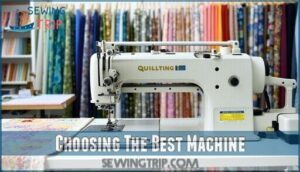This site is supported by our readers. We may earn a commission, at no cost to you, if you purchase through links.
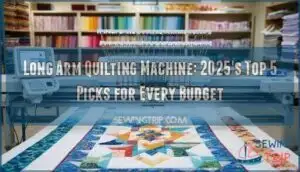
These machines feature extended throat space ranging from 12 to 26 inches, allowing you to maneuver king-size quilts smoothly. You’ll find models from $3,000 budget-friendly options to $30,000 computerized systems that practically quilt themselves.
The key difference from regular sewing machines? You move the machine head across a stationary quilt sandwich, creating consistent stitches at speeds up to 3,000 per minute. Whether you’re choosing a Handi Quilter, Gammill, or Janome model, throat space and stitch regulation determine your quilting success.
The right features can transform your quilting efficiency completely, making it easier to work on large projects with precision and speed.
Table Of Contents
Key Takeaways
- You’ll need at least 18 inches of throat space to handle larger quilts efficiently, with 26+ inches giving you the freedom to work on king-size projects without wrestling with bunched fabric.
- Your budget determines your features – entry-level machines start around $3,000 for basic functionality, while computerized systems with automated quilting and pattern programming can exceed $30,000.
- Stitch regulation technology is essential for consistent results, keeping your stitches uniform regardless of how fast or slow you move the machine head across the quilt.
- You’ll complete projects faster with higher stitches-per-minute capabilities (2,200+ SPM recommended) and features like automatic thread cutters that minimize downtime and maximize your quilting productivity.
Long Arm Quilting Basics
Long arm quilting machines feature throat spaces ranging from 15 to 26 inches, with ideal performance starting at 18 inches for handling larger quilts efficiently.
You’ll need to understand key specifications like stitches per minute (1,800 to 3,100 SPM), stitch regulation modes for consistent results, and frame requirements that determine your workspace needs.
Throat Space Importance
Your long arm quilting machine’s throat space determines everything from quilt size to project complexity.
Your throat space is your creative canvas—choose wisely to unlock your quilting potential.
Think of it as your creative canvas—15 inches handles lap quilts, while 18+ inches tackles king-size masterpieces.
Handi Quilter machines offer various quilting space options to match your workspace needs.
Larger throat space means better maneuverability around intricate designs, but consider your studio’s physical limitations when choosing quilting machine sizes.
A larger throat space also improves efficiency through effortless fabric manipulation via effortless fabric manipulation, enhancing your overall quilting experience with better results.
Stitches Per Minute Impact
Your long arm quilting machine’s stitches per minute directly determines how fast you’ll complete projects.
Higher SPM translates to better productivity gains and reduced quilting time.
Consider these SPM ranges when evaluating quilting machine performance:
- 1,800-2,000 SPM: Budget-friendly machines with decent quilting speed for beginners
- 2,200-2,500 SPM: Mid-range options balancing motor performance with stitch quality
- 2,800+ SPM: Professional-grade machines maximizing fabric compatibility and productivity
Stitch Regulation Modes
Modern quilting machine stitch regulators offer two primary modes that’ll transform your quilting experience.
Precision Mode delivers consistent stitch lengths regardless of your hand speed, while Cruise Control maintains steady stitches per minute for flowing patterns.
Advanced sensor technology monitors your movement, automatically adjusting needle timing to guarantee perfect stitch consistency.
Proper regulation calibration is essential to ensure that you achieve steady stitches per minute across your entire quilt surface, resulting in a professional finish.
Machine Size Considerations
When selecting your long arm quilting machine, consider your studio space first.
Frame footprint varies dramatically—some machines need 80 square feet for a 10-foot frame.
Throat space determines quilt size capacity, while portability options matter if you’ll move locations.
Storage needs include fabric, batting, and finished quilts.
Measure twice, buy once for effective quilting space management.
Buying Long Arm Machines
When you’re ready to purchase a long arm quilting machine, you’ll need to evaluate throat space, stitches per minute, and stitch regulation features that match your quilting projects.
Your budget will determine whether you choose a basic model starting around $8,000 or invest in computerized systems with advanced features that can exceed $13,000.
Key Features to Consider
When shopping for your long arm quilting machine, throat space determines your project size—aim for 18+ inches.
Stitch regulation keeps your stitches consistent, while machine speed affects productivity.
Frame size must match your workspace, and display type impacts ease of use.
These quilting machine features directly influence your quilting space efficiency and overall satisfaction with your investment.
Computerized Options
Computerized quilting machines transform your creative process through automated quilting capabilities and pattern programming.
Design software like Statler Stitcher and ProStitcher enables precise stitch automation, letting you create intricate patterns with computerized efficiency.
These quilting automation systems store custom designs, repeat patterns flawlessly, and maintain consistent tension.
You’ll complete projects faster while achieving professional results every time, with the help of computerized efficiency.
Frame and Table Types
Your quilting machine frame choice determines your work style and comfort level.
Standing vs. sitting affects your quilting approach, while frame material impacts stability and durability.
Consider these frame essentials:
- Rack systems let you walk around quilts for better reach
- Table setups provide seated comfort during long sessions
- Adjustable heights accommodate different users and ergonomic needs
Space requirements vary dramatically—10-foot frames need substantial studio room.
Budget and Cost Factors
Beyond the initial investment of $8,000 to $13,000, you’ll face ongoing operating costs for thread, batting, and maintenance.
Budget machines start around $3,000, while premium models exceed $15,000.
Many dealers offer financing options with monthly payments under $200.
Factor in quilt pricing potential—custom quilts command $0.02-0.05 per square inch, helping offset your quilting machine investment over time.
Long Arm Quilting Machine Types
You’ll find long arm quilting machines in three main categories: computerized models with automated features, manual machines that rely on hand-guided control, and hybrid systems that combine both approaches.
Each type offers different throat spaces ranging from 15 to 26 inches, with speeds from 1,800 to 3,100 stitches per minute to match your quilting needs and budget.
Handi Quilter Features
Through precision engineering and thoughtful design, Handi Quilter’s long arm quilting machine lineup delivers exceptional performance.
The Capri 18 features impressive throat space and HQ Stitch regulation technology. You’ll appreciate the Avante UV lighting system for enhanced visibility.
The Glide Wheel kit guarantees smooth movement, while the reliable Bobbin Case maintains consistent thread tension throughout your quilting projects.
Whatever’s Quilted is a dealer that offers Handi Quilter machines and services.
Janome Quilt Maker Features
The Janome Quilt Maker Pro 18 delivers professional-grade performance with its laser focus technology and advanced editing capabilities.
You’ll experience precise stitch regulation at 2,200 stitches per minute, making this long arm quilting machine ideal for professional use.
Its computerized settings and automation systems streamline complex projects, while quilting machine features enhance your creative control and productivity.
It also features a digital tension control system with an LCD touchscreen.
Gammill and Baby Lock Options
Gammill and Baby Lock stand out among quilting machine brands for different reasons.
Gammill’s Statler offers superior automation starting at $42,999, while their Classic models focus on exceptional Gammill Stitch Quality.
Baby Lock’s Regent delivers reliable automation at $4,000, and the Crown Jewel reaches $16,249 with premium software.
For those interested in exploring options, you can find Gammill quilting products online.
These longarm quilting machines excel in specific quilting applications based on your budget and skill level.
Quilting Machine Accessories
You’ll maximize your long arm quilting machine’s potential with the right accessories that enhance precision, comfort, and efficiency.
Essential add-ons like LED lighting systems, precision-glide wheel kits, grip gloves, and specialized bobbin cases transform your quilting experience from basic stitching to professional-grade results.
Essential Accessories List
Starting out with your long arm quilting machine accessories doesn’t have to break the bank. You’ll need quilting rulers for precise patterns, plus essential bobbin management tools and various needle types.
Don’t forget workspace ergonomics items like anti-fatigue mats and grip gloves. Quality quilting machine frames and tables enhance stability, while tension tools guarantee consistent stitching results.
Consider adding specialty presser feet for advanced techniques.
Lighting and Visibility Options
Good lighting transforms your quilting machine workspace from squinting frustration into clear precision.
You’ll need proper illumination to see fine details and maintain consistent stitching quality. To enhance visibility, consider options for specialized machine illumination.
Consider these lighting essentials for your long arm quilting machine:
- LED Brightness with adjustable intensity prevents eye strain during long sessions
- Shadow Reduction through multiple light sources eliminates dark spots around your needle
- Color Temperature between 4000K-5000K provides natural daylight clarity
Directional lighting and strategic light placement create the perfect quilting environment.
Handle Bars and Control Systems
While good lighting sets the stage, your long arm quilting machine’s handlebars and control systems determine how smoothly you’ll navigate those illuminated projects.
Modern quilting machine handlebars offer handlebar adjustability and ergonomic design features that reduce fatigue during extended sessions.
| Feature | Benefit | Impact | Consideration |
|---|---|---|---|
| Handlebar Adjustability | Custom height positioning | Reduces back strain | Measure your comfortable reach |
| Digital Interface | Touch controls at fingertips | Faster speed changes | Learn button layouts first |
| Precision Control | Micro-adjustments possible | Cleaner stitch lines | Practice smooth movements |
| Vibration Dampening | Steadier machine operation | Better stitch quality | Check rubber grips regularly |
Your quilting machine control systems work like a car’s steering wheel – they need to feel natural in your hands.
Quality quilting machine handlebars feature precision control mechanisms that respond to subtle movements, while vibration dampening technology keeps your machine steady during high-speed quilting.
Consider upgrading to long arm models for enhanced reach and control.
The digital interface should be intuitive, allowing you to adjust settings without breaking your creative flow.
Maintenance and Repair Tips
Regular quilting machine maintenance keeps your investment running smoothly for years.
Follow manufacturer oiling schedules, typically every 8-10 hours of use.
Master tension adjustments for different thread weights and perform needle changes every 8-12 hours.
Proper bobbin care prevents thread snags.
Keep a troubleshooting guide handy for quick fixes, or contact quilting machine repair services for complex issues.
Choosing The Best Machine
You’ll need to match your quilting machine’s specifications to your workspace, projects, and budget requirements.
Consider throat space requirements, stitching speed capabilities, and whether you’ll benefit from computerized features or prefer manual control for your quilting style.
Speed and Efficiency Factors
Your long arm quilting machine’s stitches per minute directly impact project throughput and profitability.
Machines delivering 2,200+ SPM with reliable stitch regulation slash production time substantially.
Quilting automation systems boost efficiency while reducing operator fatigue through ergonomics impact.
Smart SPM optimization balances speed with quality, ensuring consistent results.
Downtime reduction features like automatic thread cutters and large bobbins maximize your quilting time investment.
Regular maintenance can also help prevent common thread issues and reduce downtime, improving overall productivity.
Arm Length and Workspace
Your long arm quilting machine’s throat space directly impacts what you can create.
Most quilters need 18-20 inches minimum for standard quilts, while 26+ inches handles king-size projects effortlessly.
Your studio dimensions matter too – plan for 10-12 feet of quilting space around your quilting frame.
- Quilt Size: Match throat space to your typical project dimensions
- Studio Dimensions: Allow 3+ feet clearance on all sides of your quilting machine
- Ergonomic Considerations: Choose standing or sitting height based on comfort preferences
- Space Optimization: Consider foldable frames for smaller quilting spaces
Brand and Model Selection
With a dozen top manufacturers competing for your attention, brand reputation becomes your north star when selecting the best longarm quilting machine.
The King Quilter II ELITE and Handi Quilter Capri 18 lead through proven reliability, while Grace Company Qnique offers budget-friendly alternatives.
Feature comparison across APQS, Baby Lock, and BERNINA models guarantees your investment matches project scale and space constraints perfectly.
Quilting Style and Technique Considerations
Your quilting approach determines which machine features matter most.
Free-motion quilting demands excellent stitch regulation and smooth handlebars for fluid movement.
Custom design techniques benefit from computerized patterns and programmable settings.
Consider your preferred basting methods – some machines excel at spray basting integration.
Thread selection compatibility varies between models, affecting tension control and quilting techniques you’ll master.
Frequently Asked Questions (FAQs)
How much does longarm quilting cost?
Your wallet’s about to feel lighter than a feather! Longarm quilting machines cost $8,000 to $13,000+, while professional quilting services charge based on quilt size, typically ranging from $02 to $05 per square inch.
What is the alternative to a long-arm quilting machine?
Instead of buying a long-arm machine, you can use domestic sewing machines, mid-arm quilters, or hand quilting.
These options cost less and require smaller workspaces while still producing beautiful finished quilts.
How much money does a long-arm quilter make?
Professional quilters typically earn $15-35 per hour or charge $02-05 per square inch.
You could make $20,000-50,000 annually depending on your client base, efficiency, and whether you’re running a full-time quilting business.
Is it hard to use a long-arm quilting machine?
Like riding a bike, you’ll wobble at first but find your rhythm quickly. Modern machines have stitch regulation and intuitive controls that make learning straightforward—expect basic proficiency within days.
How difficult is it to learn to use a longarm quilting machine?
Learning takes 3-6 months of regular practice.
You’ll master basic movements in weeks, but developing smooth technique and speed requires patience.
Start with simple patterns and gradually build your skills through consistent quilting sessions to achieve speed.
What maintenance and cleaning does a longarm machine require?
Sarah’s machine started skipping stitches after six months of daily use—a classic sign of neglected maintenance.
You’ll need regular cleaning, oiling (if required), lint removal, and professional servicing to keep your machine running smoothly.
How often should long arm machines be serviced?
You’ll want professional servicing every 12-18 months for heavy users, or annually for occasional quilters.
Regular maintenance between services keeps your machine running smoothly and prevents costly repairs down the road.
Can beginners learn long arm quilting effectively?
Beginners can become brilliant long arm quilters with proper preparation.
You’ll master basic techniques quickly using stitch regulators and precision modes.
Start with simple patterns, practice consistently, and don’t rush—even experts began somewhere, and with time, you’ll become proficient in precision modes.
What thread types work best for machines?
Cotton and polyester threads perform exceptionally well in long arm machines.
You’ll get smooth stitching with 40-weight cotton for general quilting, while polyester offers strength and sheen.
Avoid metallic threads—they’ll cause tension headaches.
Do long arm machines handle thick batting?
Most long arms handle batting up to 3 inches thick with ease.
Your machine’s throat space and needle system work together beautifully, letting you quilt through heavy wool or cotton batting without skipping stitches or jamming, which is a result of the machine’s ability to handle thick batting.
Conclusion
Choosing your perfect long arm quilting machine transforms quilting from a wrestling match into pure artistry.
You’ve explored throat space requirements, stitch regulation systems, and budget considerations that’ll guide your decision.
Whether you’re investing in a $3,000 entry-level model or splurging on a $30,000 computerized system, the right machine multiplies your quilting efficiency exponentially.
Remember, your chosen long arm quilting machine becomes your creative partner for years, so prioritize features matching your quilting goals and workspace limitations.

